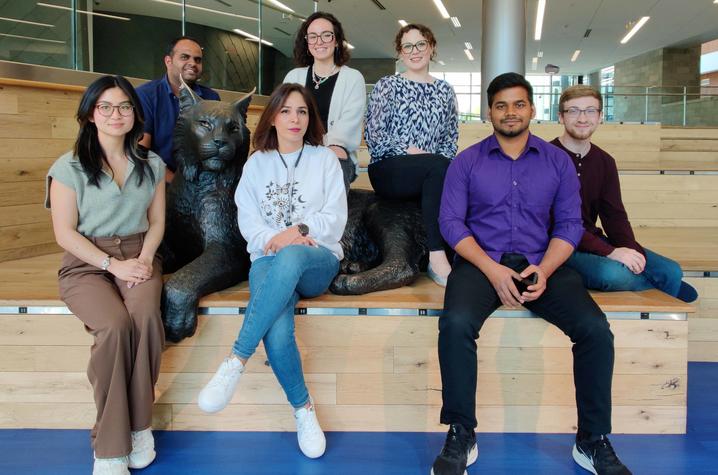Paterson paper advances organic electronics field

Merit analysis is a vital element of the scientific process, ensuring that research is based on rigorous evidence and sound methodology. It enables scientific advancement, boosts credibility, quality and reliability for future research. It allows a research community to build a common language, common practices and common logic.
Sometimes a discovery that contradicts merit analysis, and the so-called “figures of merit” on which performance benchmarking depend, results in a sea change for a research field. One such change may have just occurred in the labs of the University of Kentucky’s Center for Applied Energy Research (CAER).
A new paper from Alexandra F. Paterson’s organic electronics group, “The organic electrochemical transistor conundrum when reporting a mixed ionic-electronic transport figure of merit,” challenges traditional practices in organic electronics, specifically organic mixed ionic-electronic conductors (OMIECs) and organic electrochemical transistors (OECTs). It was recently published in Nature Materials. You can find the full paper online here.
Conductors (materials that easily conduct electricity) and transistors (the on-off switches of those materials) are the bread-and-butter of our electronically driven world. Every phone, computer, light switch and vehicle has transistors. Typically, these are made of silicon and non-renewable resources. Paterson’s lab focuses on creating transistors utilizing organic (carbon-based) materials that are more flexible than their rigid counterparts.
“Nowadays, we have billions of transistors in a smartphone. These transistors are so fundamental to our society — imagine how much impact we could have if we developed transistors with new, organic, more environmentally friendly materials with different mechanical properties, that can be used in new environments,” Paterson said.
The properties of OMIECs and OECTs are vital for many applications. From wearable biosensors and body machine interfaces to neuromorphic computing, chemical sensing, health care and agriculture, these materials are on the cutting edge of advanced technologies.
As research progresses, costs are reduced and efficiency improves. The Paterson lab, supported projects in Kentucky's National Science Foundation (NSF)-sponsored Established Program to Stimulate Competitive Research (EPSCoR) and UK CAER have published several papers and continue to advance innovations in this field. One such Paterson lab paper, published in Advanced Science in July 2023, explored chemical doping as an innovative approach to enhance the performance of OECTs.
However, as the Paterson lab’s latest paper explores, there is perhaps a conundrum with OECTs when it comes to the µC* (microcoulomb) product. The µC* product reflects the ability of an organic material to efficiently conduct electricity, while storing charge, and it is the OMIEC and OECT system “figure of merit.” Figures of merit are used to benchmark the performance of materials and devices as well as guide future development. Directly extracting the µC* product from OECTs is becoming routine in organic bioelectronics and organic electronics communities.
The Paterson lab paper shows that, in certain cases, OECTs can give inaccurate µC* products, by inflating it significantly beyond its actual value. This marks the first publication on the accuracy of the µC* product, and the first time an exponential channel resistance has been reported in OECTs — the latter finding explains the cause of the overestimations.
“This work is important for the organic electronics community because, if this parameter is not extracted correctly, it can misguide the entire field, curtail acceleration and progression, impact publications and lead to rejected funding applications. Misreported and incorrect figures of merit, extracted from electronic devices, take years to rectify,” Paterson said. “This publication is timely because it can raise concerns of incorrect figure of merit analysis within the field before it becomes widespread throughout the literature.”
Paterson’s team on this paper includes postdoctoral scholar Maryam Shahi, graduate researchers Vianna N. Le and Paula Alarcon Espejo, with collaborators from the University of Oxford including Iain McCulloch, Ph.D., a professor of polymer chemistry, postdoctoral scholar Christina Kousseff and graduate student Maryam Alsufyani.
This research aligns with KY NSF EPSCoR’s Track-1 project, Kentucky Advanced Partnership for Enhanced Robotics and Structures (KAMPERS), which is in its fifth year of the five-year project, focusing on advancing manufacturing in Kentucky. Paterson is a new faculty hire supported by the project and started in 2021.
Paterson works alongside Track-1 co-principal investigator John Anthony, UK CAER Associate Director Matt Weisenberger, and several others across UK, the University of Louisville and other institutions. All are focused on developing compatible suites of printable insulators, conductors and semiconductors for structurally integrated electronics, as well as fully integrating sensing, logic and communication into those structures using 3D printing and related techniques. OECTs play a significant role in these objectives.
“Something our group is interested in is the concept of introducing novel electronic materials into traditional or existing transistor structures because this process often results in nuanced and unexpected device characteristics,” Paterson said. “If we understand the phenomena behind these new behaviors, it not only gives a better understanding of current devices but also leads to the discovery of new device concepts and design rules. This is a path to establishing new applications for organic electronics.”
This material is based upon work supported by the National Science Foundation under Cooperative Agreement No. 1849213. Any opinions, findings, and conclusions or recommendations expressed in this material are those of the author(s) and do not necessarily reflect the views of the National Science Foundation.
Credits
Kevin Puckett (UK CAER & KY NSF EPSCoR)

